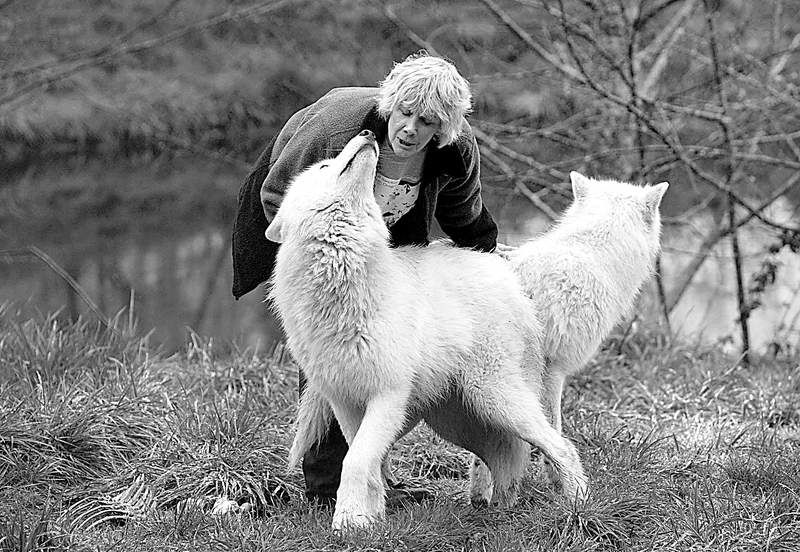White wolves, far from the Arctic
Published 5:00 am Sunday, April 19, 2009

- Lois Tulleners is greeted earlier this month by two of the 10 Arctic wolves she takes care of at the White Wolf Sanctuary. The facility, east of Waldport, accepts just Arctic wolves. “Arctic wolves were so rare and beautiful, I just fell in love with them,” Tulleners says.
WALDPORT — You can hear the wolves long before you see them. Their unmistakable drawn-out howls float lightly on the breeze before you reach the 10-foot-high chain-link fence that marks the beginning of the animals’ domain. Their home, found on a gravel road tucked into the Coast range east of Waldport, is known as the White Wolf Sanctuary.
Once you reach the center of the sanctuary, they are there, too: 10 regal snow-white Arctic wolves, carefully watching with yellow eyes as they pace the perimeter of their huge wire-enclosed territories, their tongues the color of Pink Pearl erasers — at the ready to greet visitors who befriend them.
Arctic wolves are a subspecies of the gray wolf that originates in the cold climate above the Arctic Circle. These Arctic wolves all have been rescued from domestic circumstances that ranged from owners’ ill health to neglect to outright abuse. They have been brought to the sanctuary to live the rest of their lives in near-wild comfort.
‘This is my life’
It’s the brainchild-cum-obsession of Lois Tulleners, who left behind previous careers as a singer and band member, manufacturer of exercise equipment, karate school entrepreneur and private eye to answer the call of the semi-wild.
“When her father heard she had bought this place, he said, ‘What else is that girl going to do?’” Tulleners’ mother, Rose White, recalls.
Nothing, because, “this is my life,” is Tulleners’ quick answer. “I have a better relationship with these animals than most people — it’s my responsibility to give them the most natural lives they can have.”
She first encountered the wolf personality when a long-ago boyfriend acquired two wolf-dog hybrids, then left them with her when the couple broke up. She began studying the pure species, Canis lupus, and “the more I learned about wolves, the more I became obsessed with their plight,” Tulleners says. “Wolves are one of the most persecuted animals in the world.”
It shouldn’t be so, she argues. “Wolves are the top of the food chain, and when the wolf population is healthy, all other animal and plant populations are healthy.”
She knows farmers and ranchers take a different view, but she’s talking ecosystems, not economics.
The wolves “are natural controllers of herbivores,” keeping their numbers down so they don’t destroy too much vegetation, which leads to erosion and further destruction of habitat, Tulleners says. “There’s a scientific basis for encouraging a well-balanced wolf population.”
Of course, for her personally, maintaining her private wolf population is as much emotional as scientific.
“When I first started, Arctic wolves were so rare and beautiful, I just fell in love with them,” Tulleners says. Her devotion drove her to create the sanctuary just for the white wolves, which means she has had to turn down other types of wolves and animals in need of a home.
As a nonprofit sanctuary, she has to meet federal regulations that maintain her certification with the U.S. Department of Agriculture.
“If you’re just going to keep a wolf as a pet, you are licensed through the state Department of Agriculture, but it’s federal when you have a sanctuary,” she says. “I have to meet all the requirements for fencing, food preparation, water quality, health and medication. There’s a whole book on what you have to do to meet the federal regulations. And they do send the inspectors out.”
That’s never been a problem for White Wolf Sanctuary, she says proudly. “One year, they wrote us up as the best facility they’ve seen.”
Room for wolves
Of her 60 acres of land surrounded by national forest, 47 are dedicated to fenced-in wolf habitat, Tulleners says.
The fences are set up to form five different enclosures “in kind of a circle” around the property. The runs vary in size, up to 23 acres, and two wolves reside in each space.
The enclosures are connected with a series of lanes and gates that allow wolves to be escorted from one area to another without coming in direct contact with each other.
Tulleners’ house is at the center of the property, where all the enclosures meet, and she can give educational instruction to visitors from her porch in full view of the wolves, if they choose to make themselves available.
Adult Arctic wolves raised in captivity generally range in weight from 110 to 175 pounds. While life expectancy in the wild is about eight years, wolves in sanctuaries easily can live 15 years.
Oregon’s climate may not be ideal for the Arctic wolf, “but when it snows, they really love it,” Tulleners says. “Most of the time they stay outside their shelters, but when the weather gets really rough, they go inside.”






